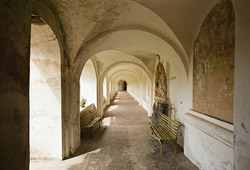Way of the Cross
The Way of the Cross, with 39 stations, is an essential part of the Tytuvėnai shrine. Beside the stations, under glass covers, is earth from Jerusalem that was brought here in the 18th century by the Bernardine monk Antanas Burnickis (1715–1770). According to the number of stations, this is the largest known Way of the Cross in Lithuania today.
Among the stations, 25 are frescos painted on dry plaster while the other 14 are stucco sculptures. The details of urban architecture in the painted scenes and the eastern characterizations show the artist’s desire to present these Gospel scenes realistically. The current condition of the frescos is poor. Many of them have been irreparably damaged due to weather conditions, moisture and lack of timely maintenance. The stations composed of stucco sculptures transmit the drama of the scenes better than the painted ones do, and each of the rococo relief works is unique. The stations in the corners of the passageway are fashioned as small altars, in a form of 18th century baroque expression that stresses the notion of sacrifice.
The division of this Way of the Cross into painted and sculpted stations follows the practice common at larger-scale “Calvaries” of distinguishing between the Path of Christ’s Arrest and the Path of Christ’s Cross. The painted stations on the Way of the Cross at Tytuvėnai roughly correspond to the events in the story of Christ’s arrest, while the sculpted stations follow Christ from Pilate’s palace to the place of his death. The painted and sculpted stations alternate throughout the covered passage, meaning that pilgrims wishing to make the entire Tytuvėnai “Calvary” need to make two trips through the gallery – the first time to follow the Path of Christ’s Arrest, and the second, the Path of Christ’s Cross. The stations are arranged in such a way that the gateway leading from the town into the courtyard coincides with the station “Christ’s Entrance into Jerusalem”. Thus pilgrims entering the courtyard in a way identify themselves with Christ entering Jerusalem.








